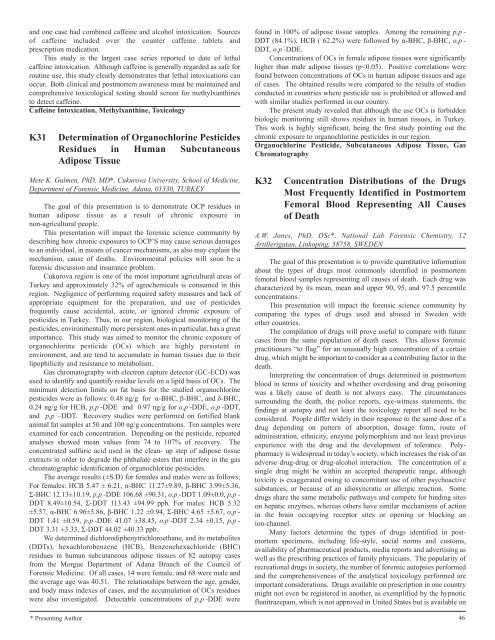FORENSIC TOXICOLOGY - Bio Medical Forensics
FORENSIC TOXICOLOGY - Bio Medical Forensics
FORENSIC TOXICOLOGY - Bio Medical Forensics
Create successful ePaper yourself
Turn your PDF publications into a flip-book with our unique Google optimized e-Paper software.
and one case had combined caffeine and alcohol intoxication. Sources<br />
of caffeine included over the counter caffeine tablets and<br />
prescription medication.<br />
This study is the largest case series reported to date of lethal<br />
caffeine intoxication. Although caffeine is generally regarded as safe for<br />
routine use, this study clearly demonstrates that lethal intoxications can<br />
occur. Both clinical and postmortem awareness must be maintained and<br />
comprehensive toxicological testing should screen for methylxanthines<br />
to detect caffeine.<br />
Caffeine Intoxication, Methylxanthine, Toxicology<br />
K31 Determination of Organochlorine Pesticides<br />
Residues in Human Subcutaneous<br />
Adipose Tissue<br />
Mete K. Gulmen, PhD, MD*, Cukurova University, School of Medicine,<br />
Department of Forensic Medicine, Adana, 01330, TURKEY<br />
The goal of this presentation is to demonstrate OCP residues in<br />
human adipose tissue as a result of chronic exposure in<br />
non-agricultural people.<br />
This presentation will impact the forensic science community by<br />
describing how chronic exposures to OCP’S may cause serious damages<br />
to an individual, in means of cancer mechanisms, as also may explain the<br />
mechanism, cause of deaths. Environmental policies will soon be a<br />
forensic discussion and insurance problem.<br />
Cukurova region is one of the most important agricultural areas of<br />
Turkey and approximately 32% of agrochemicals is consumed in this<br />
region. Negligence of performing required safety measures and lack of<br />
appropriate equipment for the preparation, and use of pesticides<br />
frequently cause accidental, acute, or ignored chronic exposure of<br />
pesticides in Turkey. Thus, in our region, biological monitoring of the<br />
pesticides, environmentally more persistent ones in particular, has a great<br />
importance. This study was aimed to monitor the chronic exposure of<br />
organochlorine pesticide (OCs) which are highly persistent in<br />
environment, and are tend to accumulate in human tissues due to their<br />
lipophilicity and resistance to metabolism.<br />
Gas chromatography with electron capture detector (GC-ECD) was<br />
used to identify and quantify residue levels on a lipid basis of OCs. The<br />
minimum detection limits on fat basis for the studied organochlorine<br />
pesticides were as follows: 0.48 ng/g for α-BHC, β-BHC, and δ-BHC,<br />
0.24 ng/g for HCB, p,p ’ -DDE and 0.97 ng/g for o,p ’ -DDE, o,p ’ -DDT,<br />
and p,p ’ –DDT. Recovery studies were performed on fortified blank<br />
animal fat samples at 50 and 100 ng/g concentrations. Ten samples were<br />
examined for each concentration. Depending on the pesticide, repeated<br />
analyses showed mean values from 74 to 107% of recovery. The<br />
concentrated sulfuric acid used in the clean- up step of adipose tissue<br />
extracts in order to degrade the phthalate esters that interfere in the gas<br />
chromatographic identification of organochlorine pesticides.<br />
The average results (±S.D) for females and males were as follows;<br />
For females: HCB 5.47 ± 6.21, α-BHC 11.27±9.89, β-BHC 3.99±5.36,<br />
Σ-BHC 12.13±10.19, p,p ’ -DDE 106.68 ±90.31, o,p ’ -DDT 1.09±0.0, p,p ’ -<br />
DDT 8.49±10.54, Σ-DDT 113.43 ±94.99 ppb. For males: HCB 5.32<br />
±5.57, α-BHC 6.96±5.86, β-BHC 1.22 ±0.94, Σ-BHC 4.65 ±5.67, o,p ’ -<br />
DDT 1.41 ±0.59, p,p ’ -DDE 41.07 ±38.45, o,p ’ -DDT 2.34 ±0.15, p,p ’ -<br />
DDT 3.31 ±3.33, Σ-DDT 44.02 ±40.33 ppb.<br />
We determined dichlorodiphenytrichloroethane, and its metabolites<br />
(DDTs), hexachlorobenzene (HCB), Benzenehexachloride (BHC)<br />
residues in human subcutaneous adipose tissues of 82 autopsy cases<br />
from the Morgue Department of Adana Branch of the Council of<br />
Forensic Medicine. Of all cases, 14 were female, and 68 were male and<br />
the average age was 40.51. The relationships between the age, gender,<br />
and body mass indexes of cases, and the accumulation of OCs residues<br />
were also investigated. Detectable concentrations of p,p ’ -DDE were<br />
* Presenting Author<br />
found in 100% of adipose tissue samples. Among the remaining p,p ’ -<br />
DDT (84.1%), HCB ( 62.2%) were followed by α-BHC, β-BHC, o,p ’ -<br />
DDT, o,p ’ -DDE.<br />
Concentrations of OCs in female adipose tissues were significantly<br />
higher than male adipose tissues (p






